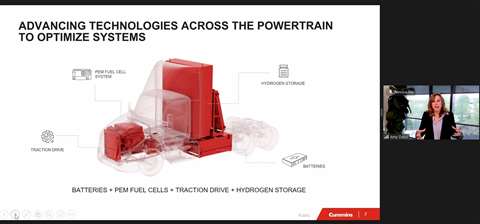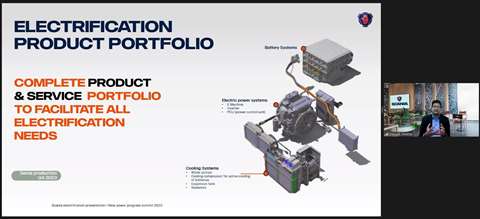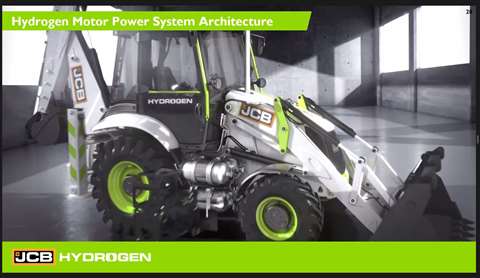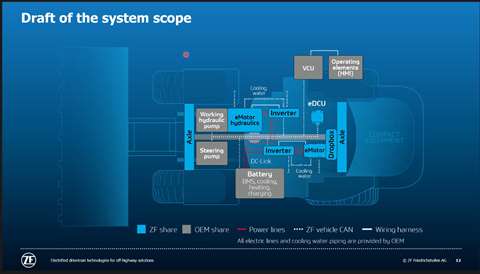NPP Summit: Is H2 or batteries the right path to carbon neutrality?
06 May 2022
Industry experts say the answer for industrial and commercial equipment isn’t one or the other but rather multiple solutions
To address the theme “Technologies for CO2 Neutrality,” New Power Progress (NPP) Summit 2022, an online event held on Tuesday, May 3, 2022, brought together five leading powertrain suppliers to discuss the technologies under development that they believe will enable customers to meet aggressive CO2 neutrality targets in commercial and industrial equipment applications.
 JCB’s Tim Burnhope and Julian Buckley, editor of Diesel Progress International, are shown in this screen capture from the 2022 New Power Progress Summit.
JCB’s Tim Burnhope and Julian Buckley, editor of Diesel Progress International, are shown in this screen capture from the 2022 New Power Progress Summit.
The event was sponsored by Lawsons Global Recruitment and organized by New Power Progress, Diesel Progress, Diesel Progress International and KHL Events. Diesel Progress International Editor Julian Buckley was the program’s MC.
Leading off the summit was keynote speaker Amy Davis, president of the New Power division, Cummins Inc. While Cummins has a 100-plus year history in diesel engines and related systems, Davis sees her division as the “future of what we’re going to be as a company.”
According to Davis, Cummins believes there is still plenty of room in diesel technologies, including in hybrid solutions. It is also developing a line of internal combustion engines that can leverage natural gas and potentially hydrogen, all with minimal change to the base engine. “As fleets are starting to decarbonize and trying to transition their fleets, they’ll have less disruption to their application, to how they run their operations and to the actual installation in their trucks,” she noted.
However, a combination of solutions will be required to successfully reach what Cummins dubs Destination Zero – ambitious carbon neutrality goals set by companies and countries globally. As such, Cummins has invested more than a billion dollars since 2017 in new technologies including battery electric components, electric vehicle drivetrain components, fuel cells and even electrolyzers.
 Amy Davis talks about Cummins’ approach to new powertrain technology in this screen capture from the 2022 New Power Progress Summit.
Amy Davis talks about Cummins’ approach to new powertrain technology in this screen capture from the 2022 New Power Progress Summit.
“We’ve provided [electrolyzers] into fueling stations but also coupled them with wind and solar and hydraulic… power solutions to make green hydrogen, and also partnered with companies that can distribute it and start to build out the infrastructure to make hydrogen fueling a reality,” said Davis.
Since stationary fuel cells utilizing both PEM (proton-exchange membrane) and solid oxide technologies offer “a green and feasible way” to start to decarbonize the power grid, Cummins is actively working on projects to commercialize these technologies, as well.
Such a broad array of solutions will be needed to meet the unique power needs and duty cycles of commercial and industrial applications. “A lot of people talk about is it going to be battery or is it going to be fuel cells, which is why we have a strong position that it is not one or the other,” said Davis.
It is also not one single platform within the different fueling alternatives. Cummins is working to combine the right battery chemistries and sizing, as well as drivetrain and fuel cell efficiencies, to create optimized solutions that can meet duty cycle needs across the full spectrum of machine sizes.
“It’s no easy feat but [these are] the kind of application-specific solutions that we think are going to make it feasible for fleets and different commercial applications to actually decarbonize,” said Davis. “Because at the end of the day, it’s going to be their total cost of ownership, how they run their equipment, that’s going to matter, and we’re paying a lot of attention to that.”
Cummins has various iterations of these solutions now on the road and in the field providing insight on duty cycles and system demands, which will inform whole system design optimization and customization for its customers.
“Technology providers like us need leading edge fleet customers, application end users, who will trial the technology, put it in situ, so that we can see how it performs, learn together and start to optimize,” said Davis, adding, “I believe it’s not this iteration of technology that’s going to win. It’s actually going to be the next one or the next one.
“It’s really a complex kind of transition that we have on this Destination to Zero. One solution will not win, for sure,” she continued. “We believe it’s not just a coupling of hydrogen and batteries, but it’s optimizing those technologies to the application to avoid disrupting the way transportation and industrial applications work today.”
A modular approach to electrification
 Deepak Shekhar, product manager, E-mobility Solutions for Scania, talks about the challenges of electrification - and the company’s approach to solving those challenges - in this screen capture from the 2022 New Power Progress Summit.
Deepak Shekhar, product manager, E-mobility Solutions for Scania, talks about the challenges of electrification - and the company’s approach to solving those challenges - in this screen capture from the 2022 New Power Progress Summit.
Scania also believes in the need for flexible solutions to address specific machine size and duty cycle requirements in industrial applications. To meet power demands across the full equipment size and use spectrum, it will be launching a compact, electric power system unit for industrial applications in Q3 2023, announced Deepak Shekhar, product manager, E-mobility Solutions, in his presentation.
This system integrates an electrical machine (e-machine) inverter and power control unit with fully electric propulsion or a hybrid solution. “The system can be used in a different configuration depending on the requirement from the customer, and therefore it brings a high level of modularity between the platforms,” said Shekhar.
Already proven in Scania trucks, the electric power system is currently being tested in pilot projects, including in a hybrid configuration in a dump truck running empty uphill and fully loaded downhill. The pilot has shown several benefits for customers, including energy recovery capabilities.
“We saw that the braking energy while… coming downhill could be recuperated using the e-machine and it could be used to charge the battery,” said Shekhar. That energy can then be applied to the application cycle. “It leads to downsizing the engine and a significant fuel and CO2 reduction.”
Scania plans to make the system scalable to enable industrial OEM customers to grow with it. “We clearly see that the applications are very, very diverse and there is no solution which fits all,” Shekhar commented. “So, we have a very modular approach to the market so that we can find good synergy and work along with the customers so that they can scale up the product.”
Progress in hydrogen combustion engines
During his presentation, Tim Burnhope, chief innovation and growth officer, noted JCB’s journey on the Road to Zero – or Off-road to Zero, as the company prefers to call it for its market sector – with the development of an electric mini-excavator featuring existing and proven batteries and components. It has since introduced seven different battery electric compact equipment models in a variety of machine types.
 Tim Burnhope talks about JCB’s work with hydrogen fuel cells and engines in this screen capture from the 2022 New Power Progress Summit.
Tim Burnhope talks about JCB’s work with hydrogen fuel cells and engines in this screen capture from the 2022 New Power Progress Summit.
Initially, engineers hoped to scale up the battery technology to JCB’s mid-size and larger machines. But they quickly encountered the “charge limit time” – the point where the charging time required was roughly equivalent to the hours of work the machine could perform on that charge. “And then also that becomes a point where it’s almost unrealistic to keep stacking batteries for batteries sake, especially on certain products,” Burnhope stated.
So, JCB moved on to explore the prospects of hydrogen technology. “Our first thoughts were the excitement of using a hydrogen fuel cell,” said Burnhope. However, the appropriate size of fuel cell wasn’t available, so the initial prototype developed included a hybrid fuel cell system complemented by a large battery pack. This has since been replaced by a prototype featuring a right-sized fuel cell.
This second 20-ton fuel cell-powered prototype has been running for roughly a year and a half, providing insight that will be used for future development. “We like to understand what’s good about the technology and what’s bad. We like to understand how the technology needs to mature,” said Burnhope. “And more importantly, we need to ensure that it has the right level of complexity and the right cost for the market.”
Results thus far have generated some concerns for the short-erm future of fuels cells in off-highway equipment. “In the short term, we believe that the technology has some way to go and we need to work with fuel cell developers to fix three or four key areas,” Burnhope stated.
Still convinced of hydrogen’s potential and impatient to move forward, JCB turned its attention to hydrogen combustion. To avoid repeating past missteps, the company began by evaluating past efforts in hydrogen combustion – including 76 papers highlighting previous research – to identify why the technology didn’t catch on, only discover that they were all based on conversions of existing diesel or gasoline engines.
Consequently, JCB chose instead to develop a dedicated hydrogen fuel engine. To enable a largely drop-in solution, the bottom two-thirds are pretty much the same as a traditional engine. The remainder of the engine on top is an entirely new combustion system designed to effectively utilize hydrogen fuel.
The first hydrogen combustion engines were up and running by the end of December 2020, with numerous iterations developed since. “I think we’re up to iteration 14 now, where we’ve refined and we’ve refined and we’ve refined,” said Burnhope.
The first prototype hydrogen combustion machines were developed in March 2021, with a host of machines now running. “We’re evaluating to ensure that we can get the same torque curves, the same performance, the same efficiency levels, and really how we can create products that are completely normal to today’s product,” said Burnhope.
“Our customers are really excited because it’s probably a premium of 15% to 20% rather than 70% for electric, and who knows what the fuel cells will turn out to be,” he added. “They’re very, very excited to start in creating net-zero sites – to get started to take net-zero construction moving forward.”
Fuel cells in marine applications
Benjamin Oszfolk, systems engineer, Fuel Cell Energy Storage Systems Marine, Rolls-Royce Power Systems, addressed the use of fuel cells for power generation in marine environments, their technical characteristics and the integration challenges that come with the technology, utilizing a ferry to illustrate commercial application.
While he acknowledged the opportunities with the technology, Oszfolk highlighted a number of the obstacles that must be overcome to make fuel cells a more viable alternative to combustion engines.
“If we want to get a fuel cell into an application, we will first have to implement an electric power transmission, which is not common in most of the applications today,” he stated. “We also need to carefully size the fuel cell and the battery in terms of dynamic response. Moreover, we need to size the fuel cell to customer load profile, taking into account the efficiency characteristics of the fuel cell…”
Other considerations that must be addressed include:
- galvanic isolation issues
- higher cooling requirements
- the interaction of the fuel cell with the battery during operation
- added space required for onboard fuel storage
- more frequent refueling to compensate for the fuel’s lower energy density
“And last but not least, we need to implement appropriate testing and validation procedures during the development to ensure reliable and safe products,” Oszfolk concluded.
No one size fits all solution
Peter Tepfenhart, product manager for Construction Machinery, and David Stockbauer-Muhr, head of Electric Systems development for Off-Highway Applications, ZF Off-Highway Business Unit, echoed the sentiment of other presenters as to the “no one fits all solution” to carbon neutrality in a presentation on electrified drivetrain technologies for off-highway applications.
“In the future, we will have different primary energy sources. On the compact size on up to the mid-size of the vehicle, we see the battery as the energy source. From a mid-size up to the large vehicle size, we see the fuel cell as an energy source,” said Tepfenhart. “And parallel to that… we still need to offer solutions for combustion engines, either the standard diesel as an energy source or alternative synthetic fuels or hydrogen as a fuel.”
 An example of ZF’s electrified drivetrain for a compact wheel loader is show in this screen capture from the 2022 New Power Progress Summit.
An example of ZF’s electrified drivetrain for a compact wheel loader is show in this screen capture from the 2022 New Power Progress Summit.
ZF is positioned to serve all of the different energy sources. For example, the new eTrac electric drives, which can use a battery or a fuel cell as the energy source, as well as the ErgoPower and cPower powershift and power split transmissions for use with internal combustion engines.
“We see a clear demand for drop-in solutions in the market, which is a basis for integration of the new drivetrain solutions into existing vehicle architectures,” said Tepfenhart. “We need modular platforms… We have to be able to present and to offer scalable and flexible systems with a high degree of reuse.” For example, the same axles can be reused with a conventional driveline and an electric drivetrain.
“The goal was always to offer products with superior performance and very good efficiency. Of course, this requires a long expertise in power management and comprehensive system optimization,” stated Tepfenhart. “This will be our key for the future to develop reliable and also cost viable solutions for the market.”
More than 500 people registered for this year’s NPP Summit. A video of the complete program will be made available shortly: watch www.dieselprogress.com and www.newpowerprogress.com for more information.
STAY CONNECTED



Receive the information you need when you need it through our world-leading magazines, newsletters and daily briefings.
CONNECT WITH THE TEAM








